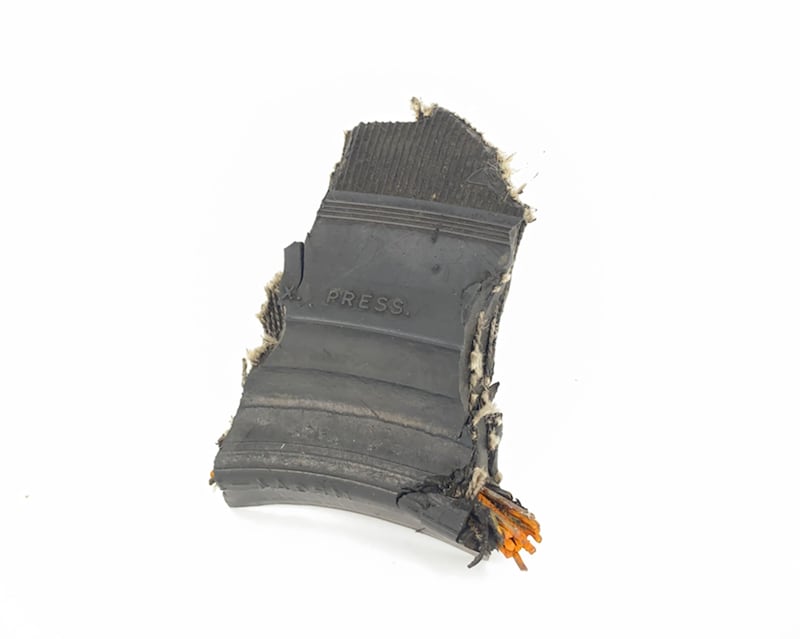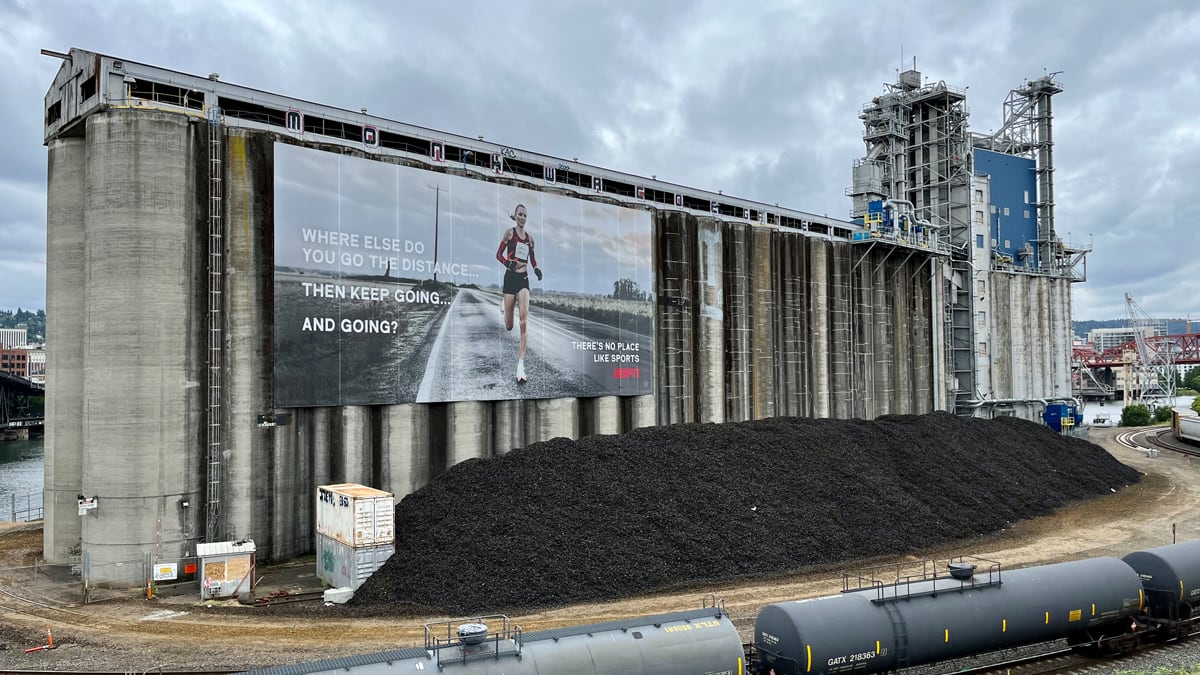On July 17, a rusty cargo ship named Petra sailed up the Willamette River and docked at the old Louis Dreyfus grain terminal, just across Interstate Avenue from Moda Center.
For the next five days, a swarm of front-loaders roared around the terminal and packed the ship with an unusual cargo: tons upon tons of scrap tires, shredded into cookie-sized chunks.
During that time, Rich Roberson, a patent lawyer, ran by the grain elevator and saw the large cloud of dust kicked up by the earth movers.
“The distinct smell of rubber can be smelled well past the [Oregon] Convention Center,” said Roberson, 45, in an email to WW on July 18.
The arrival of the Petra, the front-loaders, and the dust cloud are clues about what’s going on at one of Portland’s most puzzling properties.

The terminal went from mundane to mystery in June 2019, when global grain merchant Louis Dreyfus Co. sold the facility for $164,000, just six years after spending $21.5 million to renovate it. The price didn’t make any sense, and neither the seller nor the buyer would comment on it.
In February 2021, Beau Blixseth, son of one of Oregon’s most notorious timber barons, bought the elevator for $2.9 million through an entity called Castle Arden 1 LLC. (Blixseth’s father, Tim, started the ultra-luxe Yellowstone Club in Montana, then spent years dashing around the world in a fleet of private jets, wooing the rich and famous to the private ski and golf resort before he lost the club in an ugly divorce and spent many months in a Montana jail for contempt of court.)
Beau Blixseth, 42, is a deal-maker like his father. His specialty, too, is real estate. In an interview last month, Blixseth said he wanted to find a tenant that would use the terminal for grain again (“Grain Delay,” WW, June 29). In the meantime, he said, it would handle scrap tires for a tenant, Castle Tire Recycling.
But Castle Tire was more than a tenant. Property records show that Castle’s founder is the co-owner of the terminal. Castle Tire is owned by Chandos Mahon, a Columbia Business School grad whose middle name is Castle, according to public records. Hence the name.
Asked about Castle’s ownership in a June interview, Blixseth said Mahon was indeed half owner of Castle Arden 1, the LLC that owns the elevator. But Mahon is press shy, Blixseth said. Indeed, Mahon didn’t return phone calls or emails seeking comment.
Mahon’s ownership, along with the massive pile of tires, suggests the old Louis Dreyfus terminal may be in the business for some time to come. Last month, Blixseth said he’d been trying to get a grain shipper to use the silos, with no luck.
If the tire shipments continue, so too might the clouds of dust and the stink of rubber (tire shards line the access road from Interstate to the terminal, too). That raises the question of who regulates a grain silo that’s piled high with hydrocarbons on the Willamette River.
“It definitely seems like something that would require a stormwater permit given how this material can degrade into smaller and smaller bits that could be flushed into the river,” says Travis Williams, executive director of the environmental watchdog Willamette Riverkeeper. “It’s not high science to figure out how to keep these materials on site. Let’s hope they are taking the proper steps to do that.”
Perhaps. Oregon Department of Environmental Quality spokeswoman Susan Mills says Tire Disposal & Recycling, an affiliate of Castle Tire with the same address, operates under a DEQ “waste tire storage and carrier permit” at its facility on Harborgate Street, just west of Bybee Lake, far up in North Portland, where it shreds the tires.
“Once processed, DEQ considers the shredded tires to be ‘product,’” Mills said in an email. “Since product moves (is transported/sold), it does not require a waste permit, so one is not required at the grain elevator site.”
But that may not be the end of it. Businesses are allowed to store up to 100 waste tires before they need a “DEQ waste tire storage permit,” Mills says.
“The grain elevator site has been assigned to someone on the Solid Waste Management Team,” she adds, “and they will be going out in the next couple of weeks to see about the current tire situation.”
Pollution-wise, the bigger questions about Blixseth’s tire pile might involve where the Petra is heading and why.
Tires are hazardous waste. They are full of metals and chemicals, and if you dump them in a field, like so many people do, they fill with rain and breed disease-carrying mosquitoes. They’re made to be durable as hell, so they last forever.
And there are a lot of them. Every year, 1.6 billion new tires hit the road, and about 1 billion wear out and become trash, according to a 2020 report by Goldstein Market Intelligence. But only about 100 million are recycled into rubberized asphalt concrete for roads, or ground up to make artificial turf for sports fields (where there is now concern about carcinogens).
For better or worse, they burn really well. Plants making paper and cement often use them for fuel. With proper emissions controls, burning tires is permitted in many places. But in some countries, including Malaysia and India, people use small, jury-rigged kilns to turn tires into low-grade oil, according to a 2019 investigation by Reuters.
Those backyard ovens spew thick smoke full of chemicals, Reuters reported. Many of them run on tires imported from Europe and the U.S. “For many developed countries, shipping tires abroad is cheaper than recycling them domestically,” Reuters says.
In the June interview, Blixseth said Castle Tire gathers tires for fuel in South Korea and Japan, where most nuclear plants remain idle since a tsunami slammed into the Fukushima plant in 2011. A Metro regional government memo about Tire Disposal & Recycling says its shredded tires “are either exported to Asian markets for use as tire-derived fuel or transported to an authorized landfill for disposal.”
Ship-tracking websites allow anyone to trace vessels like the Petra. At last check, it was at the Port of San Diego. That could be the final destination for its cargo, or it could be picking up more tire shards and heading to Asia.
Mahon remains silent, and Blixseth has stopped returning messages, so it’s hard to know where the Petra is heading and what’s in its belly.

